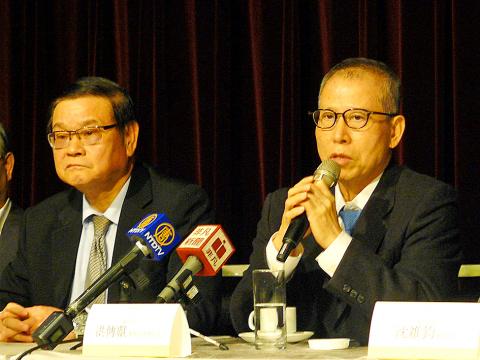Solar cell maker Neo Solar Power Energy Corp (新日光能源) yesterday said it has received government support to finance a three-way merger in the latest restructuring efforts — worth NT$5 billion (US$168.92 million) — to boost profitability by penetrating all levels of the solar supply chain.
It is a strategy created by Neo Solar and local partners Gintech Energy Corp (昱晶能源) and Solartech Energy Corp (昇陽光電) to counteract price volatility in the solar cell market by rapidly diversifying into a lucrative solar system installation business.
“We are not forming a big solar cell alliance,” Neo Solar chairman Sam Hong (洪傳獻) told a media briefing yesterday. “We are creating a different business model — a winning formula — via this three-in-one merger.”

Photo: CNA
Within five years after the merger, the new entity, which is to be named United Renewable Energy Co (UREC, 聯合再生), seeks to generate between NT$90 billion and NT$100 billion in revenue, almost doubling current revenue of NT$50 billion, Neo Solar said.
The solar system installation business would be the greatest source of revenue at about 50 percent, while solar cell and solar module businesses would constitute the remaining 50 percent, the company said.
UREC aims to build solar power plants with a capacity of 1 gigawatt (GW) each year past the initial five-year period, said Gintech president Pan Wen-whe (潘文輝), who is to serve as chief executive officer.
The merger should be completed in the third quarter of this year, Hong said, adding that he did not expect the merger to face major obstacles from the world’s competition watchdogs as the new company would only install 5GW of solar cell capacity a year.
Hong’s remarks about creating a new business model is aimed at alleviating public concern that the government’s investment might end up with a zero return as all three solar cell makers are struggling to make a profit amid steep pricing competition from China and anti-dumping probes from the global community.
The government might inject more capital than the NT$4 billion fund into UREC through the government’s National Development Fund and government affiliate Yao Hua Glass Co (耀華玻璃).
The government fund and Yao Hua would each hold through a private placement less than 6.5 percent of the company’s shares, because the government wants to play a smaller role than UREC’s biggest private shareholder, Delta Electronics Inc (台達電), which is to hold a 6.5 percent stake.
UREC also plans to raise additional funds by issuing new shares.
The company is to concentrate on installing solar systems for clients, while manufacturing solar cells, solar modules and solar wafers at lower costs due to falling raw material sourcing costs and better productivity, Hong said.

GROWING OWINGS: While Luxembourg and China swapped the top three spots, the US continued to be the largest exposure for Taiwan for the 41st consecutive quarter The US remained the largest debtor nation to Taiwan’s banking sector for the 41st consecutive quarter at the end of September, after local banks’ exposure to the US market rose more than 2 percent from three months earlier, the central bank said. Exposure to the US increased to US$198.896 billion, up US$4.026 billion, or 2.07 percent, from US$194.87 billion in the previous quarter, data released by the central bank showed on Friday. Of the increase, about US$1.4 billion came from banks’ investments in securitized products and interbank loans in the US, while another US$2.6 billion stemmed from trust assets, including mutual funds,

Micron Memory Taiwan Co (台灣美光), a subsidiary of US memorychip maker Micron Technology Inc, has been granted a NT$4.7 billion (US$149.5 million) subsidy under the Ministry of Economic Affairs A+ Corporate Innovation and R&D Enhancement program, the ministry said yesterday. The US memorychip maker’s program aims to back the development of high-performance and high-bandwidth memory chips with a total budget of NT$11.75 billion, the ministry said. Aside from the government funding, Micron is to inject the remaining investment of NT$7.06 billion as the company applied to participate the government’s Global Innovation Partnership Program to deepen technology cooperation, a ministry official told the

Taiwan Semiconductor Manufacturing Co (TSMC, 台積電), the world’s leading advanced chipmaker, officially began volume production of its 2-nanometer chips in the fourth quarter of this year, according to a recent update on the company’s Web site. The low-key announcement confirms that TSMC, the go-to chipmaker for artificial intelligence (AI) hardware providers Nvidia Corp and iPhone maker Apple Inc, met its original roadmap for the next-generation technology. Production is currently centered at Fab 22 in Kaohsiung, utilizing the company’s first-generation nanosheet transistor technology. The new architecture achieves “full-node strides in performance and power consumption,” TSMC said. The company described the 2nm process as

JOINT EFFORTS: MediaTek would partner with Denso to develop custom chips to support the car-part specialist company’s driver-assist systems in an expanding market MediaTek Inc (聯發科), the world’s largest mobile phone chip designer, yesterday said it is working closely with Japan’s Denso Corp to build a custom automotive system-on-chip (SoC) solution tailored for advanced driver-assistance systems and cockpit systems, adding another customer to its new application-specific IC (ASIC) business. This effort merges Denso’s automotive-grade safety expertise and deep vehicle integration with MediaTek’s technologies cultivated through the development of Media- Tek’s Dimensity AX, leveraging efficient, high-performance SoCs and artificial intelligence (AI) capabilities to offer a scalable, production-ready platform for next-generation driver assistance, the company said in a statement yesterday. “Through this collaboration, we are bringing two